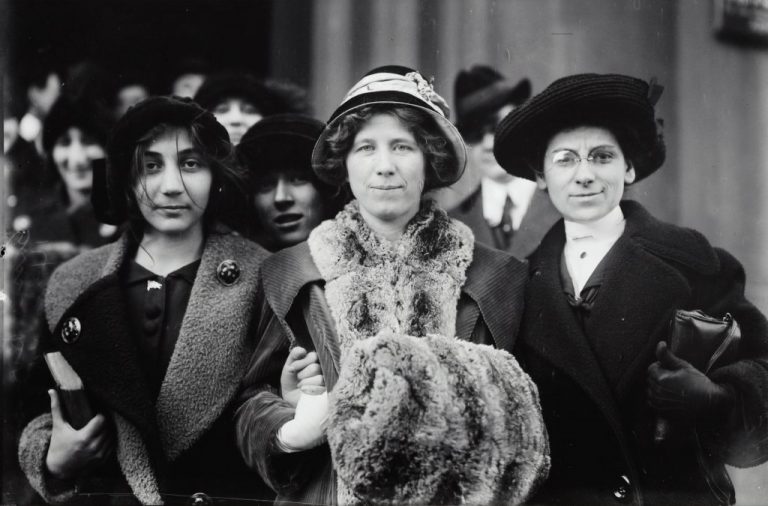 magine seeing a poster today that reads “Convicts, Lunatics and Women. Have No Vote in Parliament…” This was written by Emily J. Harding Andrews during the Women’s Suffrage in England c. 1908-1917 and can be seen at the Library of Congress in Washington, DC. Women’s suffrage was a pivotal moment in the battle for equality, but women still faced many forms of discrimination. In 1920, The Nineteenth Amendment to the Constitution was ratified, ensuring the right of women to vote. Women have made great strides in the 100 years since their right to vote was ratified in the Constitution, but there remain many inequalities that must still be changed.
magine seeing a poster today that reads “Convicts, Lunatics and Women. Have No Vote in Parliament…” This was written by Emily J. Harding Andrews during the Women’s Suffrage in England c. 1908-1917 and can be seen at the Library of Congress in Washington, DC. Women’s suffrage was a pivotal moment in the battle for equality, but women still faced many forms of discrimination. In 1920, The Nineteenth Amendment to the Constitution was ratified, ensuring the right of women to vote. Women have made great strides in the 100 years since their right to vote was ratified in the Constitution, but there remain many inequalities that must still be changed.
Government Representation
Many laws and societal attitudes meant women faced barriers and prejudice throughout society – in work, education and marriage. By 1900, every state had passed legislation granting married women the right to keep their own wages and to own property in their own name. In 1916, Jeannette Rankin, of Montana, was the first woman to be elected to the U.S. House of Representatives, and in 1932, Hattie Wyatt Caraway, of Arkansas, became the first woman elected to the U.S. Senate. Finally women were becoming a part of the government with a say in the introduction and passing of laws. Flash forward almost 50 years to 1981 when Sandra Day O’Connor became the first woman to serve on the Supreme Court. Hopefully the day of a woman president is not too far away.
Gender Pay Discrimination
 In 1963, The Equal Pay Act was passed by Congress, promising equitable wages for the same work, regardless of the race, color, religion, national origin or sex of the worker. Title VII of the Civil Rights Act passed, prohibiting sex discrimination in employment and The Equal Employment Opportunity Commission was created in 1964. Unfortunately, these laws have not corrected the gender wage gap. Therefore in 2009, The Lily Ledbetter Fair Pay Restoration Act allowed victims, usually women, of pay discrimination to file a complaint with the government against their employer within 180 days of their last paycheck. Yet, in 2018, female full-time, year-round workers still made only 82 cents for every dollar earned by men, a gender wage gap of 18 percent. These percentages are even higher for Black women and other ethnic groups. Women, on average, earn less than men in nearly every single occupation for which there is sufficient earnings data for both men and women to calculate an earnings ratio. Our battle for equal pay rages on today.
In 1963, The Equal Pay Act was passed by Congress, promising equitable wages for the same work, regardless of the race, color, religion, national origin or sex of the worker. Title VII of the Civil Rights Act passed, prohibiting sex discrimination in employment and The Equal Employment Opportunity Commission was created in 1964. Unfortunately, these laws have not corrected the gender wage gap. Therefore in 2009, The Lily Ledbetter Fair Pay Restoration Act allowed victims, usually women, of pay discrimination to file a complaint with the government against their employer within 180 days of their last paycheck. Yet, in 2018, female full-time, year-round workers still made only 82 cents for every dollar earned by men, a gender wage gap of 18 percent. These percentages are even higher for Black women and other ethnic groups. Women, on average, earn less than men in nearly every single occupation for which there is sufficient earnings data for both men and women to calculate an earnings ratio. Our battle for equal pay rages on today.
Vote
 With primaries occurring in most states and a Presidential election in November, along with major Senate and House seats up for election, it is so important that all women utilize their hard-won right to vote for the candidates of their choice. Do not take that right for granted. Let March’s Women’s History Month motivate and empower you to not only get out and vote, but see what you can do to further other women’s causes. When we all work together, we can move mountains!
With primaries occurring in most states and a Presidential election in November, along with major Senate and House seats up for election, it is so important that all women utilize their hard-won right to vote for the candidates of their choice. Do not take that right for granted. Let March’s Women’s History Month motivate and empower you to not only get out and vote, but see what you can do to further other women’s causes. When we all work together, we can move mountains!



